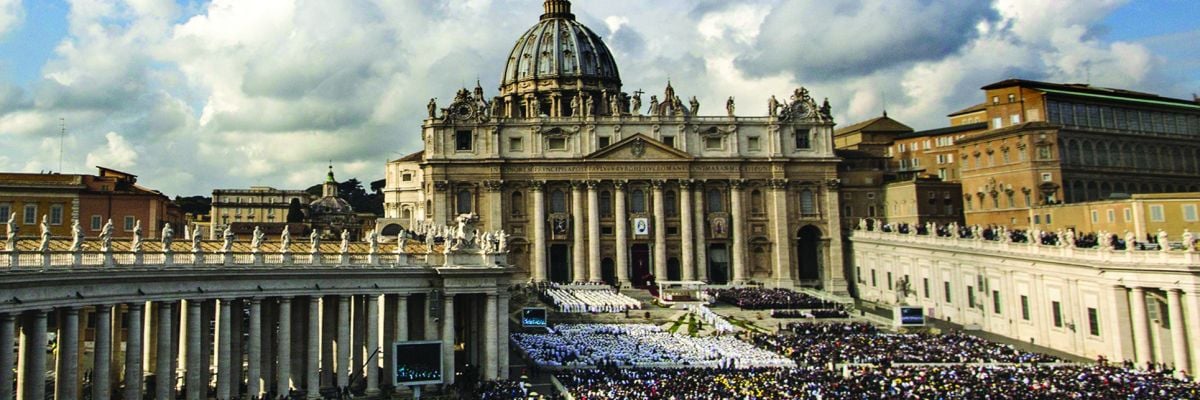
The word “Catholic” provokes a storm of controversy among Christians, alternately being coveted and reviled by different groups of non-Catholics. Some non-Catholics revile the term because they hate the Church with which it is associated, and a few loathe the very term itself. [For example, Landmark Baptists claim that there is no such thing as a general or universal church, even an invisible one which only God sees. Landmarkism claims there is only a collection of individual, local Churches, but no overall, worldwide Church which incorporates these local churches into a single body. This differs from the traditional Protestant claim that there is a single, worldwide Church made up of the invisible union of all believers]. Some Protestants have even refused to apply the term Catholic to the Church, calling it instead “the Roman Church” or “the Church of Rome.” Rather than referring to “Catholicism,” they refer to “Romanism.” Instead of speaking of the Catholic position, they will speak of the “Roman” position. [This practice is carried through with childish consistency in the writings of James White, a contemporary anti-Catholic who has a hang-up about the word Catholic. He never once uses it in an unmodified form for the Church but appends the word “Roman” to it or else drops it entirely and just uses “Roman.”].
But other Protestants have a positive attitude toward the term. Many Evangelical Protestants proclaim themselves to be “catholics” (catholics-with-a-small-“c”). They do this based on the original meaning of the word (Greek, katholikos), which was “general” or “universal.” Since they view Christ’s Church as an invisible union of all believers, a church visible only to God, membership in any particular visible communion is not necessary to be a full-fledged member of Christ’s church, hence many Protestants consider themselves to be catholic. This argument commits what is known as the etymological fallacy, the attempt to establish the meaning of a word based on its origins. Linguists have long recognized that the meaning of a word is established by its use, not by its original source. An often-cited illustration is the English word “nice,” which is derived from the Latin word nescius.
If one tried to establish the meaning of “nice” by looking at its etymology, one would conclude that it means ignorant since that is what nescius means. Thus to tell a woman she was wearing a nice hat would be to tell her that she was wearing an ignorant hat. Protestant Bible scholars themselves often point out the danger of committing the etymological fallacy.
The term “Catholic” was applied to the Church at the beginning of the second century by Ignatius, the third bishop of Antioch. During the reign of Emperor Trajan (98-117) Ignatius was taken to Rome to be executed. The exact year of the journey is uncertain, but most scholars estimate it was around 107 or 110. On the way to his death, Ignatius wrote letters to churches he was passing by or through. In his letter to the church of Smyrna, he wrote:
“Wherever the bishop appears, let the people be there, just as wherever Jesus Christ is, there is the Catholic Church.”[Epistle to the Smyrneans 8:2.]. This is the first recorded use of the phrase “Catholic Church,” but its usage almost certainly precedes Ignatius’s letter. He assumed his readers would be familiar with the term, and he uses it in an off-handed manner, suggesting he was not coining a new term, but picking up one already in use.
Protestants often see such early references as teaching nothing more than that there is a “universal church” that is not necessarily identified with any particular body of believers. While this could be claimed for Ignatius’s reference, it cannot be true for all early references. The term “Catholic” very quickly became a designation for a particular body of Christians.
One Protestant author who is honest about this is the renowned early-Church historian J. N. D. Kelly, who has written, “As regards `Catholic,’ its original meaning was `universal’ or `general’ … As applied to the Church, its primary significance was to underline its universality as opposed to the local character of the individual congregations. Very quickly, however, in the latter half of the second century at latest, we find it conveying the suggestion that the Catholic is the true Church as distinct from heretical congregations. . . . What these early Fathers were envisaging was almost always the empirical, visible society; they had little or no inkling of the distinction which was later to become important between a visible and an invisible Church” (J. N. D. Kelly, Early Christian Doctrines, 5th ed. [San Francisco: Harper, 1978], 190f).
The attempt by non-Catholics to claim “catholic” for themselves is not new. Heretics and schismatics in the fourth century tried to claim the term, yet their attempts proved unsuccessful. In 397 Augustine pointed this out using an illustration from everyday life. “[T]he very name of Catholic . . . belongs to this Church alone . . . so much so that, although all heretics want to be called `catholic,’ when a stranger inquires where the Catholic Church meets, none of the heretics would dare to point out his own basilica or house” (Against the Letter of Mani Called `The Foundation’ 4:5).
Augustine also remarked that the Church “is called Catholic not only by her own members but even by all her enemies. For when heretics or the adherents of schisms talk about her .. with strangers . . . they call her nothing else but Catholic. For they will not be understood unless they distinguish her by this name which the whole world employs in her regard.” [The True Religion 7:12, ca. A.D. 390]. Thus the fact that the Church is generally or universally (catholically) called “Catholic” forms part of its title to that name.
That “Catholic” very early acquired its modern sense of denoting a particular group of churches united in a single, visible communion is important for how we read the writings of the Church Fathers and how we read early creeds. Protestants accept the Apostles’ Creed and the Nicene Creed, which make reference to the Catholic Church. The Apostles’ Creed states, “I believe . . . in the Holy Catholic Church”; the Nicene creed states, “I believe . . . in One, Holy, Catholic, and Apostolic Church.” Both of these statements were written after “Catholic” had acquired its current meaning.
The portion of the Nicene creed that contains the reference was written in 381.[The first part of the creed, which deals with the Father and the Son, was written at the council of Nicea in A.D. 325. The second part of the creed, which begins by affirming the deity of the Holy Spirit and contains the reference to the Catholic Church, was written at the council of Constantinople I in A.D. 381. The new creed came to be called the Nicene Creed, though it would be more proper to call it the Nicene-Constantinopolitan Creed, a name so long as to demand abbreviation]. “Catholic” was added to the Apostles’ Creed in the fourth century, specifically to distinguish the Catholics who recited it from the heretics who also did so. In both creeds “Catholic” is used in its modern sense.
This is significant because Protestants emphasize the importance of reading a document in its original context. They insist on this for both sacred and secular documents. We are told that the Bible means exactly what its human authors meant, and that the U. S. Constitution must be understood based on the intentions of its framers. This is quite true. [In the case of the Bible there may be an additional layer of meaning since the divine author of Scripture may have placed meaning in the text that was not immediately obvious to the human though which he was writing. Daniel tells us the contents of a vision which he does not understand (see Dan. 12:8-10). In Gal. 4:21-31, Paul offers the allegory of Sarah and Hagar based on the text of Genesis, despite the fact that it would not be obvious to anyone reading Genesis that the text contained such an allegory. While Scripture does mean what the human author intended, it does not always mean only what the human author intended, since it had a divine author as well.]. It is a universal law of literature that the meaning of a document is established by the author’s intentions at the time he wrote it.
This principle is called the grammatical-historical method when applied to the Bible, and it is called “Constitutional originalism” or “strict constructionism” when applied to the U.S. Constitution. It is a principle which should be applied to all documents, including the creeds of the early Church. Since “Catholic” already had its modern meaning when it was placed in the creeds, the creeds must be taken to affirm belief in a single, visible communion of believers known as the Catholic Church.
Although some “non-confessional churches” in the Baptist and Pentecostal movements have rejected the creeds, most Protestants have wished to use them. As a result, they have been forced to abandon their principle of interpreting a text based on the intentions of its authors. They have had to reinterpret the creeds to fit their own particular views, which is the very thing they revile liberal theologians and liberal Supreme Court justices for doing with the Bible and the Constitution. It would be more intellectually honest if Protestants who wish to use these creeds would simply mutilate them by dropping the offensive clauses, instead of reinterpreting them and claiming that the faith of modern Protestants is the same as the faith of those who formulated the creeds.
This creed mutilation is already engaged in by some Protestants. Some Evangelicals now confess belief in “the Holy Christian Church” when they say the Apostles’ Creed. Some liberal Protestants have gone so far as to drop offensive supernatural elements from the creeds (such as belief in the resurrection of the body). Conservative Protestants might find this anti-supernaturalistic creed mutilation offensive, but at least the liberals have the courage to drop what they don’t believe in rather than reinterpreting it so that it means something completely different.



